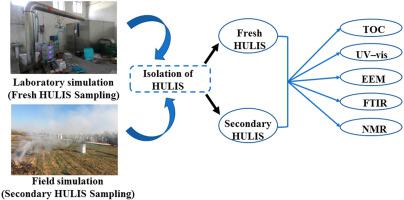Atmospheric Environment ( IF 4.2 ) Pub Date : 2021-01-22 , DOI: 10.1016/j.atmosenv.2021.118220 Yaoqiang Huo , Yin Wang , Weiming Qi , Meihe Jiang , Min Li

|
The humic-like substances (HULIS) in PM2.5 in fresh and secondary emissions of crop straw burning will result in strong light absorption of atmospheric aerosols in the near-ultraviolet and visible light region. Herein, the relative carbon contents, light absorption properties, fluorescence characteristics, FTIR and 1H NMR spectra of fresh and secondary HULIS in crop straws (wheat, rice, and corn) burning were comprehensively characterized. The results showed that the ratios of carbon contents in HULIS to water-soluble organic carbon and organic carbon (HULIS-C/WSOC and HULIS/OC) of HULIS in secondary emissions of crop straw burning were higher than that in fresh emissions. The MAE365 (mass absorption efficiencies at 365 nm) of secondary HULIS in crop straws burning were larger than that in fresh emissions. Excitation-emission matrix (EEM) spectra indicated that fresh HULIS contained phenol-like substances, which can form light-absorbing substances through secondary conversion. The spectrum of FTIR and 1H-nuclear magnetic resonance (1H NMR) showed that chemical structures of secondary HULIS in crop straws combustion were more complicated and contained more absorbing aromatic groups (e.g. aromatic rings, carbonyl groups, and aliphatic chains). Therefore, the secondary aerosol conversion may cause more aromatic structures in HULIS from crop straws burning, resulting in stronger light absorption abilities.
中文翻译:

HULIS在农作物秸秆燃烧新鲜和二次排放中的全面表征
农作物秸秆燃烧的新鲜和二次排放物中PM 2.5中的类腐殖质(HULIS)将导致近紫外和可见光区域强烈吸收大气中的气溶胶。在此,综合表征了秸秆燃烧(小麦,水稻和玉米)中新鲜和次生HULIS的相对碳含量,吸光特性,荧光特性,FTIR和1 H NMR光谱。结果表明,在秸秆焚烧的二次排放中,HULIS中的碳含量与HULIS的水溶性有机碳和有机碳(HULIS-C / WSOC和HULIS / OC)之比高于新鲜排放。MAE 365秸秆燃烧中的次级HULIS(在365 nm处的质量吸收效率)大于新鲜排放中的次级HULIS。激发-发射矩阵(EEM)光谱表明,新鲜的HULIS包含酚类物质,可以通过二次转化形成吸光物质。FTIR光谱和1 H核磁共振(1 H NMR)表明,农作物秸秆燃烧过程中次生HULIS的化学结构更为复杂,并含有更多的吸收性芳族基团(例如芳环,羰基和脂族链)。因此,二次气溶胶转化可能导致农作物秸秆燃烧引起HULIS中更多的芳香结构,从而导致更强的光吸收能力。











































 京公网安备 11010802027423号
京公网安备 11010802027423号